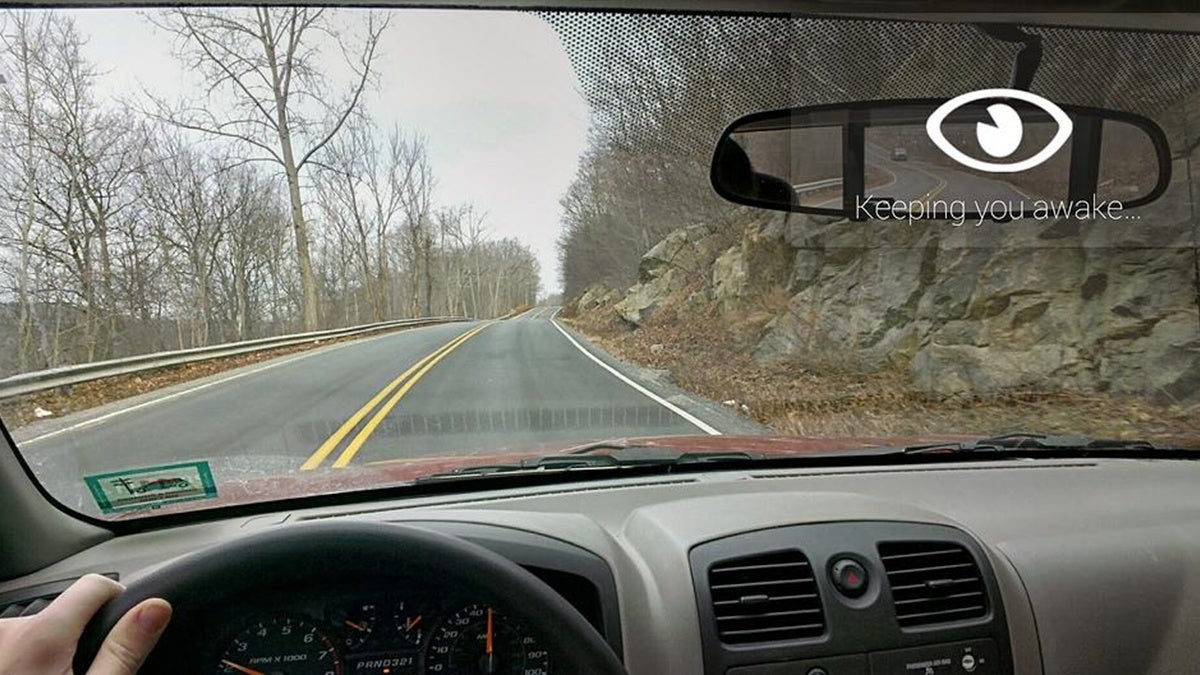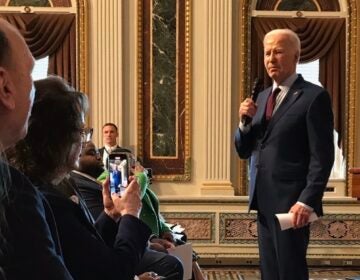Google lobbies Delaware’s proposed Google Glass ban

A driver's eye view of the Google Glass Drive Safe App (drivesafeforglass.com)
Google Glass isn’t yet available to the public, but lawmakers across the country are debating whether to ban the use of the technology while driving. Delaware is among a handful of states with legislation already in motion.
Last year, lawmakers in the First State unanimously passed House Bill 155 out of committee. The bill prohibits the use of “wearable computer with a head-mounted display” devices, such as Google Glass, while driving.
The bill’s primary sponsor, Rep. Joseph Miro (R- Pike Creek Valley), said devices like Google Glass will distract drivers, much like texting or using a cell phone.
“When you are behind the wheel and your attention, in this particular case, you’re trying to read a very small piece of glass which is about a square inch,” Miro said. “Information is guiding your eyes away from what’s in front of you.”
Advocates suggest that tech helps drivers
Google Glass advocates argue that the technology can be used in a way that actually improves driver safety.
Jake Steinerman is the co-founder of the Google Glass Drive Safe App, which is designed to notify drivers if they’re starting to fall asleep behind the wheel.
“It uses the infrared light sensor on glass to look at the movement of your eyes to see how fast your eyes are opening and closing, to see how many winks or blinks over a certain period of time there are,” said Steinerman. “They’re also using the tilt sensor in glass and using those in conjunction to detect if you’re falling asleep or getting drowsy behind the wheel.”
Steinerman said legislators are trying to get ahead of the Glass technology before realizing the benefits it could add to the driving experience.
“It’s a big misunderstanding that people think it’s in front of your eye and it’s very distracting,” said Steinerman.
Steinerman said that the glass is displayed in the upper right corner of your eye, and drivers would glance at it similar to the way they check the review mirror.
“Say you’re getting navigation directions, you just do a quick glance up to see where the next turn is or something like that, if you need additional help outside of the audio commands that it gives you,” explained Steinerman. “You can quickly glance up and see that. I think it’s much better than having to look down at your speedometer, or your GPS unit or your smartphone at your dashboard.”
Miro said he spoke to representatives with Google about the Glass technology and even tried on a pair for himself.
“I’m not against the company Google or Google Glass at all, it’s just that the application of wearing the glass while driving would be consistent with my policy of banning the use of cell phone and texting while driving,” he said.
AAA study suggests devices are not ‘risk free’
While drivers could use the safe-driving app, they’re also free to check email, watch videos and use other programs that could be distracting.
AAA Mid-Atlantic Spokesman Jim Lardear said the organization supports Miro’s bill. Last year, AAA did research on cognitive distraction, suggesting that hands-free technology is still distracting to those behind the wheel.
“The study found that hands-free cell phone use offers no safety benefits over handheld cell phone use and that voice activated texting or emailing, a capability available with Google Glass, is one of the most mentally distracting activities a driver can engage in,” Lardear said.
“Increased mental workload and cognitive distractions can lead to a type of tunnel vision or inattention blindness where motorists don’t see potential hazards right in front of them. In addition, Google Glass could also introduce a new visual element of distraction by projecting content for a wearer via ‘heads-up’ display,” Lardear explained.
“Hands free is not risk free,” he concluded.
Google will be part of discussion
Google said the Glass is made to enhance the user’s experience in whatever they’re doing.
“Technology issues are a big part of the current policy discussion in individual states and we think it is important to be part of those discussions,” said a spokesperson for Google. “While Glass is currently in the hands of a small group of Explorers, we find that when people try it for themselves they better understand the underlying principle that it’s not meant to distract but rather connect people more with the world around them.”
Miro said the bill is likely to be brought up when legislators resume session at the end of March. He expects Google will be there to lobby.
“They don’t want the bill and what I’ve asked them to do is help me raise the level of awareness that you should not be wearing that glass while you’re driving,” he said.
WHYY is your source for fact-based, in-depth journalism and information. As a nonprofit organization, we rely on financial support from readers like you. Please give today.




